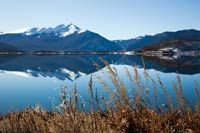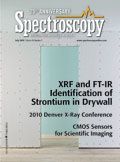DXC 2010: Going Green in the Rockies
Spectroscopy previews the annual Denver X-Ray Conference, to be held August 2–6, 2010.

The 59th Annual Denver X-Ray Conference on Applications of X-Ray Analysis will be back in Denver once again this year August 2–6. The conference will be held at the Denver Marriott Tech Center Hotel with exhibits in the Rocky Mountain Event Center on the ground floor.
Year after year, the Denver X-Ray Conference provides valuable sessions on training and education, as well as applications and papers about state-of-the-art techniques and recent developments in X-ray analysis. The conference also allows users to meet with leading manufacturers of X-ray equipment at their exhibit booths. This year's conference is sure to follow suit with many great sessions, workshops, and exhibitors.
Workshops
Workshops will be held Monday and Tuesday, August 2 and August 3, with morning sessions from 9:00 a.m. to 12:00 p.m and afternoon sessions from 2:00 p.m to 5:00 p.m. Topics include, "Survey of Basic XRD Applications," "Trace Phase Identification Using Chemical Information," "Two-Dimensional Detectors," "Trace Analysis," "Cultural Heritage I," " Using FEFF to Model Real-World Systems," and "Specimen Preparation XRF."
Plenary Session
This year's plenary session "The Greening of X-rays: X-rays and Renewable Energy," will surely be a crowd pleaser on Wednesday morning, August 4. The sessions will begin with opening remarks from chairman Robert L. Snyder and will be followed by the presentation of this year's awards.
The invited papers for this session are "Investigations of the Defect Structure of Transparent Conductors Using X-ray and Neutron Scattering Techniques," "Insights into Thermoelectric Materials: New Structures and Properties," "In-Situ Diffraction: An Important Tool for the Development of Renewable Energy Technologies," "Unraveling the Inner Workings of Energy-Related Materials Using In-Situ X-ray Absorption Techniques," and "FP-Based EDXRF Characterization of Thin Film Solar Cells."
Awards
There will be two awards presented this year during the plenary session. The Birks Award recognizes outstanding contributions to the field of X-ray spectrometry. The award was named in honor of L.S. (Verne) Birks for his many contributions to the X-ray analysis field. The 2010 Birks Award will be presented to Victor Buhrke, a consultant in Portola Valley, California.
The second award to be given out this year is the Jerome B. Cohen Award. This award was instituted in the name of Professor Jerome B. Cohen, one of the leaders in the field of X-ray analysis, and in the training of students in this art. The award is intended to recognize the outstanding achievements of student research in this field. All students, graduate or undergraduate, who are working in the field of X-ray analysis, can submit a technical paper describing their work. The award winner will be announced at the conference.
Exhibits and Poster Sessions
There will be more than 30 companies showcasing their products and answering questions in the Exhibit Hall during the week. Exhibit hours are as follows:
Monday, August 2: 12:00 p.m – 7:30 p.m.
Tuesday, August 3: 12:00 p.m – 7:30 p.m.
Wednesday, August 4: 10:00 a.m. – 5:00 p.m.
Thursday, August 5: 10:00 a.m. – 1:00 p.m.
Monday and Tuesday evening poster sessions (on XRD and XRF, respectively) from 5:30 p.m. to 7:30 p.m. will take place in the exhibit hall and the atrium outside the hall. They will both feature a wine and cheese reception, sponsored by Thermo Scientific and ICDD on Monday and Chemplex Industries, Inc. on Tuesday.
Registration
For more information and to register online, vicit the DXC website at www.dxcicdd.com. On-site registration will take place July 26–30.

LIBS Illuminates the Hidden Health Risks of Indoor Welding and Soldering
April 23rd 2025A new dual-spectroscopy approach reveals real-time pollution threats in indoor workspaces. Chinese researchers have pioneered the use of laser-induced breakdown spectroscopy (LIBS) and aerosol mass spectrometry to uncover and monitor harmful heavy metal and dust emissions from soldering and welding in real-time. These complementary tools offer a fast, accurate means to evaluate air quality threats in industrial and indoor environments—where people spend most of their time.
NIR Spectroscopy Explored as Sustainable Approach to Detecting Bovine Mastitis
April 23rd 2025A new study published in Applied Food Research demonstrates that near-infrared spectroscopy (NIRS) can effectively detect subclinical bovine mastitis in milk, offering a fast, non-invasive method to guide targeted antibiotic treatment and support sustainable dairy practices.